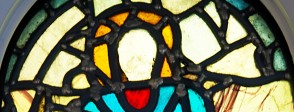Look at the image of the stained glass from Wearmouth-Jarrow in For the classroom. Ask the students to tell you what it is. How do they know? Have they seen anything similar before?
What do they think the window shows? What are they able to tell about the person – you may need to look at other examples of haloes if they are not familiar with them already. So what kind of building do the students think this window is from? Explain that this is the earliest surviving stained glass window in Britain. When do they think churches and stained glass came in to Britain? Do some research to find out.
The next two teaching ideas follow on from the halo as a symbol and use the images from A bigger picture.
Ask students to write a guide to the Christian symbols on the early Christian objects. There may be more than one symbol on each object. Extend the enquiry looking for other early symbols or other objects that show them. Use the results to create a display of time and place. Discuss the importance of having recognisable symbols for a religion that covers such a wide geographical area.
Explain that the stained glass is from a monastery in Jarrow. Ask students to find Jarrow on a modern map and then on the map of Anglo-Saxon kingdoms in For the classroom. What part of England is it in now? What was the area called in the AD 600s? What other parts of Britain were in Northumbria at that time? Compare it with a modern map to find out.
Bede was a monk at Wearmouth-Jarrow and would have looked upon this glass in the church. Find out more about Bede and what he wrote. Why is he important? Who was Benedict Biscop? What did he do? Do the students think Bede or Biscop was the more important historically?
The to-ing and fro-ing of Northumbria between paganism and Christianity and between the Irish and Roman churches is confusing, but lively. Make a detailed list of the changes from the rule of King Edwin to the Synod of Whitby: identify the change and who or what caused it. Try to create the liveliest way of communicating this information – you may find a good digital way of showing it or just use students with different hats and name badges. Discuss what the motivations were for paganism versus Christianity and for the Roman versus the Irish churches – what were the advantages and disadvantages of each?
Explore the catalogue of medieval stained glass in For the classroom. You can search by location or by subject and the results have excellent images that you can download or copy. Choose one or two examples or use the examples from Coventry Cathedral in For the classroom. Compare these with the Anglo-Saxon stained glass. What differences do the students notice? Identify the medieval technique of painting on the glass rather than just using coloured glass. Which do the students prefer?
Look at the examples of stained glass windows from Liverpool and Coventry cathedral in For the classroom or visit a local building that uses stained glass. Have a discussion about why stained glass has been used in religious buildings. What qualities does stained glass have that make it desirable in religious buildings? This could broaden into an exploration of the symbolism of light which occurs in many religions.
Ask students to create their own stained glass window. Find some other stained glass windows online to look at different shapes. Discuss how the glass is held in place and work out how to represent that appearance. You can try out a variety of different approaches to recreating the technique using different translucent materials.


